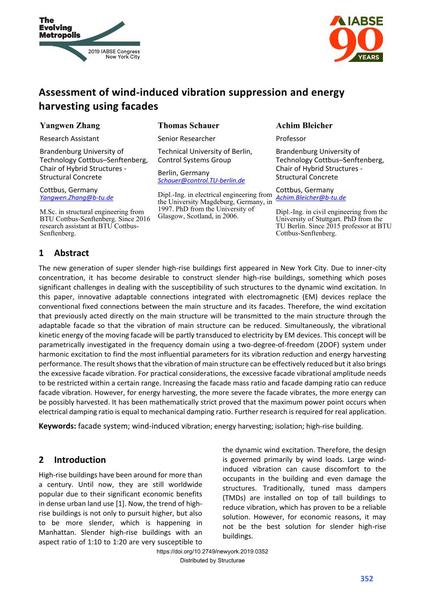Assessment of wind-induced vibration suppression and energy harvesting using facades

|
|
|||||||||||
Détails bibliographiques
| Auteur(s): |
Yangwen Zhang
(Brandenburg University of Technology Cottbus–Senftenberg, Chair of Hybrid Structures - Structural Concrete)
Thomas Schauer (Technical University of Berlin, Control Systems Group) Achim Bleicher (Brandenburg University of Technology Cottbus–Senftenberg, Chair of Hybrid Structures - Structural Concrete) |
||||
|---|---|---|---|---|---|
| Médium: | papier de conférence | ||||
| Langue(s): | anglais | ||||
| Conférence: | IABSE Congress: The Evolving Metropolis, New York, NY, USA, 4-6 September 2019 | ||||
| Publié dans: | The Evolving Metropolis | ||||
|
|||||
| Page(s): | 352-356 | ||||
| Nombre total de pages (du PDF): | 5 | ||||
| DOI: | 10.2749/newyork.2019.0352 | ||||
| Abstrait: |
The new generation of super slender high-rise buildings first appeared in New York City. Due to inner-city concentration, it has become desirable to construct slender high-rise buildings, something which poses significant challenges in dealing with the susceptibility of such structures to the dynamic wind excitation. In this paper, innovative adaptable connections integrated with electromagnetic (EM) devices replace the conventional fixed connections between the main structure and its facades. Therefore, the wind excitation that previously acted directly on the main structure will be transmitted to the main structure through the adaptable facade so that the vibration of main structure can be reduced. Simultaneously, the vibrational kinetic energy of the moving facade will be partly transduced to electricity by EM devices. This concept will be parametrically investigated in the frequency domain using a two-degree-of-freedom (2DOF) system under harmonic excitation to find the most influential parameters for its vibration reduction and energy harvesting performance. The result shows that the vibration of main structure can be effectively reduced but it also brings the excessive facade vibration. For practical considerations, the excessive facade vibrational amplitude needs to be restricted within a certain range. Increasing the facade mass ratio and facade damping ratio can reduce facade vibration. However, for energy harvesting, the more severe the facade vibrates, the more energy can be possibly harvested. It has been mathematically strict proved that the maximum power point occurs when electrical damping ratio is equal to mechanical damping ratio. Further research is required for real application. |
||||
| Mots-clé: |
bâtiment haut
|
||||
